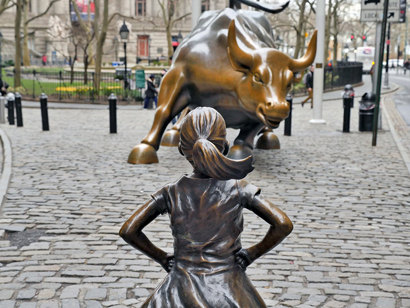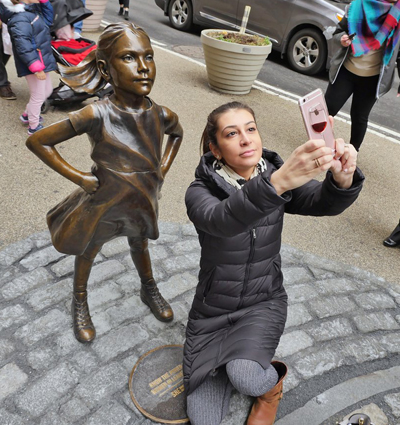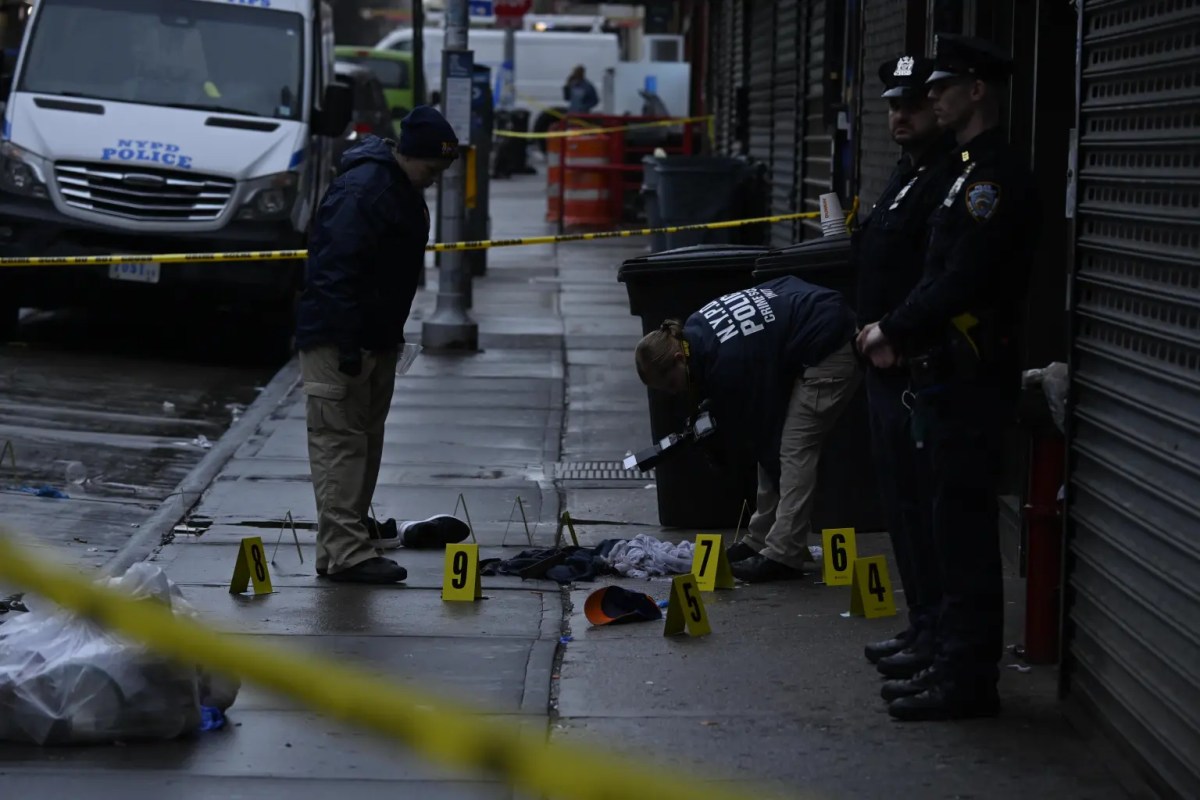
“Charging Bull” artist Di Modica argues that “Fearless Girl” derives its meaning entirely from its juxtaposition against his own work, thus making it a textbook example of copyright-violating “derivative art.”
BY COLIN MIXSON
The sculptor who created the capitalist icon says that its newly minted neighbor, feminist icon, and social media sensation is utterly derivative of his iconic brass bovine, and is demanding her big-money financier take its wildly successful marketing gimmick elsewhere — and even pay him damages for violating his legal rights.

“Charging Bull” artist Arturo Di Modica claimed State Street Global Advisors violated copyright laws with its “Fearless Girl” statue at a press conference Wednesday.
“I don’t like it,” said Arturo Di Modica, who spent $360,000 of his own money to fabricate and install “Charging Bull” opposite the New York Stock Exchange without a permit in 1989. “They’re supposed to find another place to do their advertisement.”
Attorneys for Di Modica fired off letters to State Street Global Advisors and marketing firm McCann Worldgroup, which designed the marketing stunt, on Tuesday, which accused the companies of “commercializ[ing] and exploit[ing]” ‘Charging Bull’ and violating copyright laws, before going into the Sicilian artist’s demands that she be relocated and he get paid.
“Fearless Girl,” according to Di Modica’s lawyers, wouldn’t be “fearless” if she weren’t facing down his bull, and the effect that State Street’s statue creates is entirely dependent on Di Modica’s opus.
“The statue of the young girl becomes the ‘Fearless Girl’ only because of the ‘Charging Bull,’” the letter reads. “The work is incomplete with Mr. Di Modica’s ‘Charging Bull,’ and as such it constitutes a derivative work of the ‘Charging Bull.’”
Attorney Norman Siegel cited State Street promotional materials referencing the new statue’s juxtaposition with the bull at a press conference with the artist on April 12.
“A deliberate choice was made to exploit and appropriate the ‘Charging Bull’ through the placement of fearless girl,” said.
Furthermore, by turning “Charging Bull” into a de facto emblem of misogyny, State Street unilaterally altered the public meaning of the sculpture — intended by Di Modica as a symbol of American strength in the face of the 1987 stock market crash — into an object of fear, the letter states.
“The inescapable implication is that the ‘Charging Bull’ is the source of that fear and power, and a force against what’s right,” Di Modica’s attorneys wrote to the investment firm.
But Di Modica’s main beef is that “Fearless Girl” is just an ingenious marketing scheme, with State Street aiming to make a buck off his bull.

The plaque advertising State Street’s SHE fund (seen here at the statue’s feet) remained in place until the end of March.
Throughout the media frenzy the statue enjoyed last month, State Street’s gender-diversity-tracking exchange traded fund — ticker symbol “SHE” — was featured prominently in a plaque placed at her feet, which read: “Know the power of women in leadership — SHE makes a difference.”
The plaque was removed in late March after “Fearless Girl” was enrolled in the Department of Transportation’s street art program, which has a specific signage format that the plaque didn’t adhere to, according to McNally.
Regardless, the sign proved that “Fearless Girl” was created for commercial purposes, according to Di Modica’s attorneys, therefore voiding any “fair use” protection and violating the artist’s sole right to reproduce the image of the bull for financial gain.
Ironically, more than a month before Di Modica’s press conference, the creators of “Fearless Girl” made his arguments for him in a March 10 article in AdWeek about the team at the advertising agency that came up with the idea.
In the AdWeek article, McCann’s senior copywriter Tali Gumbiner explains how the statue was explicitly conceived and commissioned as an advertisement for State Street’s SHE fund. She also makes it perfectly clear that the whole concept started from Di Modica’s bull, and that their intention, just as the artist alleges, was indeed to “change the meaning” of his work.
“How can we do this in a way that’s disruptive, and has not been done before? And the bull just came to us,” Gumbiner said. “We had to figure out a way to change the meaning of the symbol of Wall Street. Working with [McCann North America chief creative officer] Eric Silver and [worldwide CCO] Rob Reilly, the girl came from that.”
Making matters worse, it became clear early on that the statue’s corporate sponsor, State Street, is far from an ideal messenger for a righteous crusade to promote women in All Street’s leadership. Only three of State Street’s 11 board members are women, and among its 28 top executives, only five are women — a shortcoming that the company acknowledges.
“In terms of practicing what we’re preaching, we absolutely know what have further to go,” said State Street spokeswoman Anne McNally.
But some objectors have a problem not just with the messenger, but the message of “Fearless Girl” itself.
“It may be surprising to hear this, but a lot of feminists are in firm agreement that it’s time for ‘Fearless Girl’ to go.” wrote Amanda Marcotte on Salon.com over the weekend, calling the statue “infantilizing” and “a terrible symbol for feminism.”
Marcotte points out that the symbolism a little girl precociously standing arms akimbo in front of the “Charging Bull” and promising an egalitarian future largely misses the point of its supposed message — that thousands of accomplished, adult women are being discriminated against right now in a male-dominated industry. This celebration of “girl power” is noncontroversial among men who imagine their daughters as the eventual beneficiaries, she adds, but it does little to improve their attitudes towards ambitious female colleagues competing for advancement in the next year-end review.
“This all points to the deeper problem with treating ‘girl power’ as a suitable stand-in for actual feminism,” Marcotte wrote.
Regardless of the criticism, “Fearless Girl” seems likely to stand her ground for at least another year.
The statue suddenly appeared overnight on March 8, installed on a faux-cobblestone extension of the northern tip of Bowling Green, technically separating it from the park — where such installations would face much more public scrutiny — authorized through a one-week street activity permit of the sort used by street fairs and farmers markets. When the selfie magnet because an overnight social media sensation, Mayor de Blasio extended the permit for a month. After an outpouring of adoration by local pols and celebrities, the city enrolled the statue in a more permanent street art program, allowing it to remain for another year.
Where “Fearless Girl” will go from there, if she moves at all, remains to be seen.

Bowling Green Association chairman Arthur Piccolo suggested that “Fearless Girl” be moved to outside the New York Stock Exchange, where its message of gender equality would be better directed.
Di Modica and his legal team were joined at Wednesday’s press conference by Bowling Green Association chairman Arthur Piccolo, who spearheaded the effort to give “Charging Bull” a permanent home at Bowling Green back in 1989. He suggested “Fearless Girl” be moved to Broad Street and positioned to face the New York Stock Exchange, where her message of gender equality could be better directed against the real perpetrators of Wall Street’s patriarchy.
“If Fearless Girl has a message of equality, all these companies that are not practicing equality, their stock is traded at the New York Stock Exchange,” Piccolo said.
Piccolo was among the first to call out State Street’s own poor record on female empowerment, and to lodge allegations of copyright infringement. In a March 28 letter to city officials, where he wrote, “… McCann Advertising and their executives were involved and are involved in a highly coordinated, carefully planned conspiracy to defraud Arturo Di Modica of his copyright.”
The debate fueled by Di Modica’s press conference sparked dueling editorials in the tabloids last week, with the Post siding with Piccolo’s solution of moving “Fearless Girl” to the NYSE. Meanwhile, Downtown Alliance president Jessica Lappin took to the pages of the Daily News to argue that the two statues should stay together at Bowling Green, but that the girl should be moved to the south, closer to the bull, and away form the narrow northern tip, where the seflie-snapping throngs are creating a serious safety hazard.
State Street acknowledged receipt of Di Modica’s letter, although McNally declined to comment on behalf of the investment firm.
Mayor de Blasio did chime in on Twitter, however, where he accused Di Modica of sexism.
“Men who don’t like women taking up space are exactly why we need the Fearless Girl,” de Blasio tweeted in reference to a Newsweek article about Di Modica’s beef.
In response, Piccolo accused the mayor of libeling the artist, and pointed out that Seigel has filed Freedom of Information requests to uncover any communications between City Hall and State Street Global Advisors or McCann, to determine if the mayor’s office colluded unlawfully in arranging the below-the-radar approval of the project that allowed the stature and advertising plaque to appear by surprise on International Women’s Day — the same day State Street’s SHE fund began trading.

















